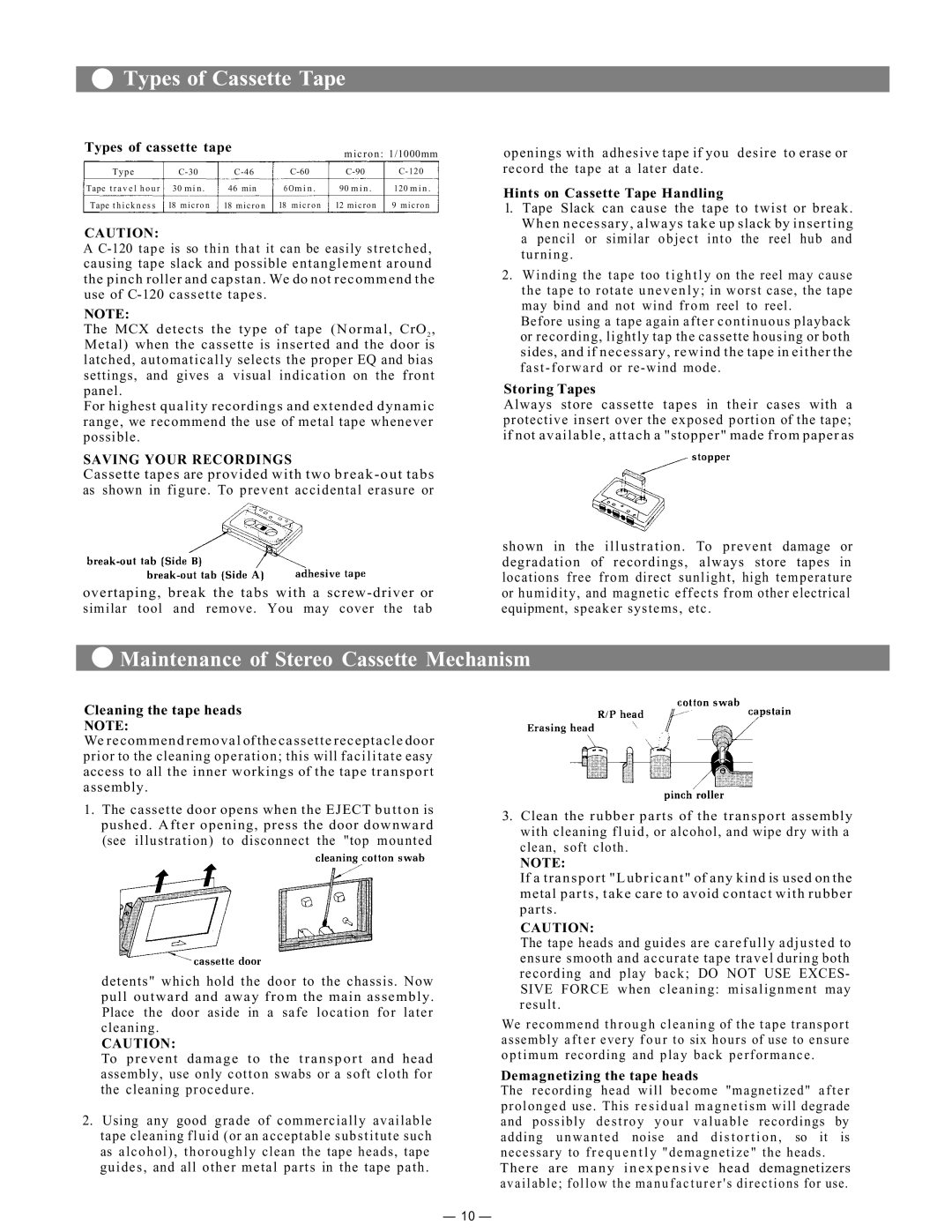
 Types of Cassette Tape
Types of Cassette Tape
Types of cassette tape |
| micron: 1/1000mm | |||
|
|
|
| ||
Type | |||||
Tape t r a v e l h o u r | 30 m i n . | 46 min | 6Om i n . | 90 m i n . | 120 min . |
Tape t h i c k n e s s | 18 micron | 18 micron | 18 micron | 12 micron | 9 micron |
CAUTION:
A
NOTE:
The MCX detects the type of tape (Normal, CrO2 , Metal) when the cassette is inserted and the door is latched, automatically selects the proper EQ and bias settings, and gives a visual indication on the front panel.
For highest quality recordings and extended dynamic range, we recommend the use of metal tape whenever possible.
SAVING YOUR RECORDINGS
Cassette tapes are provided with two
overtaping, break the tabs with a
openings with adhesive tape if you desire to erase or record the tape at a later date.
Hints on Cassette Tape Handling
1.Tape Slack can cause the tape to twist or break. When necessary, always take up slack by inserting a pencil or similar object into the reel hub and turning.
2.Winding the tape too tightly on the reel may cause the tape to rotate unevenly; in worst case, the tape may bind and not wind from reel to reel.
Before using a tape again after continuous playback or recording, lightly tap the cassette housing or both sides, and if necessary, rewind the tape in either the fast - forward or
Storing Tapes
Always store cassette tapes in their cases with a protective insert over the exposed portion of the tape; if not available, attach a "stopper" made from paper as
shown in the illustration. To prevent damage or degradation of recordings, always store tapes in locations free from direct sunlight, high temperature or humidity, and magnetic effects from other electrical equipment, speaker systems, etc.
 Maintenance of Stereo Cassette Mechanism
Maintenance of Stereo Cassette Mechanism
Cleaning the tape heads
NOTE:
We recommend removal of the cassette receptacle door prior to the cleaning operation; this will facilitate easy access to all the inner workings of the tape transport assembly.
1.The cassette door opens when the EJECT button is pushed. After opening, press the door downward (see illustration) to disconnect the "top mounted
detents" which hold the door to the chassis. Now pull outward and away from the main assembly. Place the door aside in a safe location for later cleaning.
CAUTION:
To prevent damage to the transport and head assembly, use only cotton swabs or a soft cloth for the cleaning procedure.
2.Using any good grade of commercially available tape cleaning fluid (or an acceptable substitute such as alcohol), thoroughly clean the tape heads, tape guides, and all other metal parts in the tape path.
3.Clean the rubber parts of the transport assembly with cleaning fluid, or alcohol, and wipe dry with a clean, soft cloth.
NOTE:
If a transport "Lubricant" of any kind is used on the metal parts, take care to avoid contact with rubber parts.
CAUTION:
The tape heads and guides are carefully adjusted to ensure smooth and accurate tape travel during both recording and play back; DO NOT USE EXCES- SIVE FORCE when cleaning: misalignment may result.
We recommend through cleaning of the tape transport assembly after every four to six hours of use to ensure optimum recording and play back performance .
Demagnetizing the tape heads
The recording head will become "magnetized" after prolonged use. This residual magnetism will degrade and possibly destroy your valuable recordings by adding unwanted noise and distortion, so it is necessary to f r e q u e n t l y "demagnetize" the heads.
There are many inexpensive head demagnetizers available; follow the manufacturer's directions for use.
— 10 —
